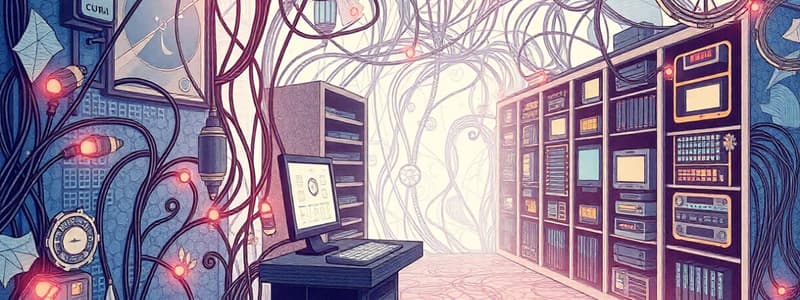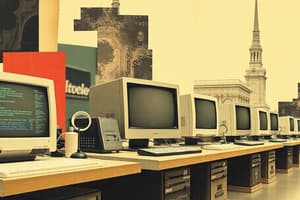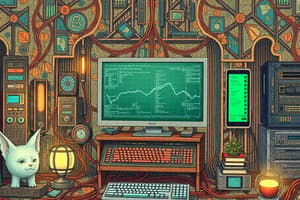Podcast
Questions and Answers
What is a computer?
What is a computer?
A programmable machine capable of performing a series of logical and arithmetic operations.
What does a 'bit' represent?
What does a 'bit' represent?
One of two states for the computer, either 0 or 1.
What is the purpose of toggling in computer operations?
What is the purpose of toggling in computer operations?
To switch from one mode of operation to another.
How many bits are typically in a byte?
How many bits are typically in a byte?
A mainframe computer only accommodates one user at a time.
A mainframe computer only accommodates one user at a time.
Which of the following best describes a supercomputer?
Which of the following best describes a supercomputer?
What is the main purpose of a server?
What is the main purpose of a server?
What characterizes a microcomputer?
What characterizes a microcomputer?
What differentiates a laptop from a desktop?
What differentiates a laptop from a desktop?
What is an average battery life for a tablet?
What is an average battery life for a tablet?
Smartphones provide access to the Internet, email, texting, references, GPS, books, and __________.
Smartphones provide access to the Internet, email, texting, references, GPS, books, and __________.
Study Notes
Recap: Information and Data
- Data is raw, unprocessed facts and figures
- Information is organized, processed data with meaning and context
- Data processing transforms data into information
Components of a Computer System
- Hardware: Physical parts of a computer system
- Software: Instructions that tell the hardware what to do
- People: Users who interact with the system
- Data: Raw input for processing
- Network: Communication system connecting devices
Introduction to Information Systems: Hardware
- Hardware includes physical components like input devices, the system unit, output devices, and storage devices.
Common Terms
- Computer: A programmable machine capable of performing logical and arithmetic operations, converting data into meaningful information.
- Bit: The smallest unit of data, represented as a 0 or 1, representing a binary digit
- Byte: A group of 8 bits used to represent a character, digit, or symbol
- Default: The pre-set setting used by a computer unless explicitly changed
- Toggle: To switch between different modes of operation - Example: the Show/Hide mode in a word processor
- Update: To install the latest patches to improve or fix a software or device driver
- Upgrade: Enhance a piece of hardware or obtain the latest version of a software program
- Boot: To power on the computer and initiate the operating system
Types of Computers and Mobile Devices
- Computers vary in size, configuration, and capabilities.
- Advancements have enabled smaller, more powerful computers with increased storage and speed
Supercomputers
- Supercomputers are the fastest, most expensive, and most powerful computers.
- Often consist of multiple high-performance computers operating in parallel.
Mainframe/Enterprise Server
- A mainframe is a large computer capable of supporting hundreds of users simultaneously.
- Features include substantial data storage, extensive memory, multiple input/output devices, and a fast processor.
- Often used in universities and hospitals
Mobile and Personal Computers
- Laptop: Portable computer with built-in display, keyboard, and touchpad
- Desktop: Stationary computer with a separate monitor, keyboard, and mouse
- Tablet: Smaller than a laptop, featuring a touchscreen interface
- Smartphone: Combines phone functionality with computing features, like internet access and applications.
Servers and Workstations
- Server: Controls access to software, hardware, and specialized services (e.g., web server, firewall server, database server)
- Workstation: A desktop computer with enhanced capabilities, more power, and memory for specialized tasks
Microcomputer/PC/Desktop
- Microcomputer: small, single-user computer with its own CPU, memory, and storage. Often referred to as PCs or desktops
- Laptops/Notebooks: Portable and smaller, offering similar power and capabilities as desktops but at a higher cost
- Netbooks: Ultra-portable laptops, smaller and cheaper than regular laptops but with less processing power
Tablets
- Tablets: Smaller than laptops but larger than smartphones, featuring a touchscreen interface.
- Internal parts are similar to computers but with a smaller, more efficient form factor, like a smaller processor.
- Often powered by rechargeable batteries lasting around 10 hours
Smartphones
- Smartphones: Devices like iPhones and Android phones, supporting phone calls, internet access, email, texting, GPS, games, and various applications
- Healthcare professionals use these devices for quick access to reference information during clinical encounters
Information System Components in Healthcare
- Healthcare Information Systems: complex, interconnected systems designed to manage and process patient data, improve efficiency, and enhance patient care.
- Hardware: Physical components like computers, servers, medical devices, and networking infrastructure
- Software: Applications used to manage workflows, record patient information, analyze data, and support decision-making
- Data: Patient information, medical records, scheduling data, financial records, and administrative data
- People: Healthcare professionals, administrators, patients, and support staff
Use of Information Systems in Healthcare
- Patient Management: Patient records, scheduling appointments, managing medications, tracking treatment plans.
- Clinical Decision Support: Providing medical professionals with evidence-based information and recommendations to aid in diagnosis and treatment plans.
- Financial and Administrative Management: Managing billing, payments, inventory, and staff payroll.
- Public Health Surveillance: Tracking disease trends, reporting outbreaks, and analyzing health data.
- Research and Development: Supporting medical research by providing data analysis, storage, and collaboration tools.
Studying That Suits You
Use AI to generate personalized quizzes and flashcards to suit your learning preferences.
Related Documents
Description
This quiz explores the essential concepts of information and data systems. It covers the differences between data and information, computer hardware components, and key terminology related to computing. Test your understanding of how these elements interact within a computer system.




